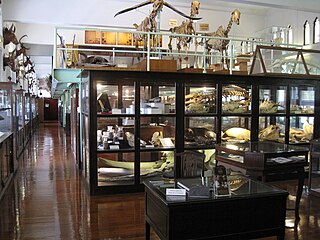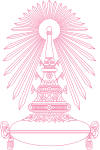
Silpakorn University (SU.) is a national university in Thailand. The university was founded in Bangkok in 1943 by Tuscan–born art professor Corrado Feroci, who took the Thai name Silpa Bhirasri when he became a Thai citizen. It began as a fine arts university and now includes many other faculties as well. In 2016, it has 25,210 students.
Sirindhorn International Institute of Technology (SIIT) is a semi-autonomous institute of technology established in 1992 within Thammasat University. It is located in Pathum Thani, Thailand. One of Thailand's research universities, it offers science, technology and engineering education, as well as related management programs. All are international programs, with English language as a medium of instruction. The institute is part of the Links to Asia by Organizing Traineeship and Student Exchange network, an international consortium of universities in Europe and Asia.

Thammasat University is a public research university in Thailand with campuses in Tha Phra Chan, Rangsit, Pattaya and Lampang Province. As of 2019, Thammasat University has over 33,000 students enrolled in 33 faculties, colleges, institutes and 2,700 academic staff.

Chulalongkorn University, nicknamed Chula, is a public autonomous research university in Bangkok, Thailand. The university was originally founded during King Chulalongkorn's reign as a school for training royal pages and civil servants in 1899 at the Grand Palace. It was later established as a national university in 1917, making it the oldest institute of higher education in Thailand.

Kasetsart University is a public research university in Bangkok, Thailand. It is the largest university in Thailand. It was Thailand's first agricultural university and Thailand's third oldest university. It was established on 2 February 1943 to promote subjects related to agricultural science. Since then, Kasetsart University has expanded its subject areas to cover life sciences, science, engineering, social sciences, and humanities. Kasetsart University's main campus is in Bangkhen, northern Bangkok, with several other campuses throughout Thailand.

Maha Chakri Sirindhorn, Princess Royal is a member of the Thai royal family. She is the second daughter of King Bhumibol Adulyadej and Queen Sirikit, and the younger sister of Maha Vajiralongkorn.

Mahidol University is an autonomous public research university in Thailand. The university was founded as part of Siriraj Hospital in 1888. It was first called the University of Medical Science in 1943, and has been recognized as Thailand's fourth public university. The university was renamed in 1969 by King Bhumibol Adulyadej for his father, Prince Mahidol of Songkhla, known as the "Father of Modern Medicine and Public Health in Thailand".

Mahasarakham University (MSU) (Thai: มหาวิทยาลัยมหาสารคาม; RTGS: Mahawitthayalai Mahasarakham, pronounced: má-hăa wít-tá-yaa-lai má-hăa-săa-rá-kaam) is a Thai public university in Maha Sarakham province, about 470 kilometres from Bangkok. In 2017 it enrolled 39,000 students.

Princess Maha Chakri Sirindhorn Anthropology Centre (SAC) is an academic institution under the Ministry of Culture in Taling Chan District, Bangkok, Thailand, established in 1992, with the aim of the systematic gathering, processing, and maintenance of anthropological data scattered throughout the country.

Faculty of Medicine Siriraj Hospital, Mahidol University is the oldest and largest medical school and the oldest of any kind of university faculty in Thailand. The faculty is now part of Mahidol University. Founded in 1889, the faculty was run in co-operation with Siriraj Hospital, the first public hospital in Thailand, which provides students with clinical experience. The faculty's campus and hospital is in the Bangkok Noi District, Bangkok, on the former Rear Palace. The medical school accepts about 250 students for undergraduate education and more than 100 to postgraduate studies each year.

Ban Mueang was a king of Sukhothai, an ancient kingdom in Thailand. He was from the House of Phra Ruang.

The Faculty of Medicine, Chulalongkorn University, the second oldest medical school in Thailand, was established in 1947 in accordance with the wishes of King Ananda Mahidol to educate a sufficient number of medical doctors to satisfy the public's demands. For more than half a century, this medical school has provided society with more than 5,000 medical doctors. The school accepts about 300 medical students and more than 100 for postgraduate residency training each year. It has consistently been ranked as one of the best medical schools in Thailand and, as of 2024, is the most competitive in terms of admissions scores.

Faculty of Pharmaceutical Sciences, Chulalongkorn University is the first Pharmacy school in Thailand, located in Bangkok. The faculty was founded by Prince Rangsit Prayurasakdi on December 8, 1913 as a department of Doctor for Compounding in the Royal Medical College, commonly called "Rong Rean Prung Ya" which means "School of Compounding Medicine". After the establishment of Chulalongkorn University in 1916, the Royal Medical College became the Faculty of Medicine under the university. The department of Compounding Medicine also had been renamed to "Panak Phat Pasom Ya" or "Doctor for Compounding Medicine Department" since April 6, 1917. It is the first time that Pharmacy Education in Thailand has been elevated in higher educational system.

The Chulalongkorn University Museum of Natural History, founded in 1954, is operated by the Chulalongkorn University's Faculty of Science in the Biology Building at the university's main campus in Bangkok, Thailand. The museum features exhibits of various organisms, including mounts of the endangered white-eyed river martin. The majority of the museum's exhibits are housed in its main hall, with dedicated rooms featuring Thai turtles and softshells, insects and land snails.

The Phra Chuthathut Palace or Sichang Palace is a former summer royal residence built during the reign of King Chulalongkorn the Great on the Sichang Island in Chonburi Province. After the French occupied the island during a conflict with Thailand over control of neighboring Laos in 1893, the royal residence was largely abandoned. Parts of the unfinished halls were removed and were used for the new Vimanmek Mansion in Bangkok. Since leaving the royal control, the palace has been used by various affiliations and authorities. Today, Chulalongkorn University occupies the palace for its "Sichang Marine Science Research and Training Station" and established the Chutathut Palace Museum of Chulalongkorn University, maintaining and preserving the palace.

The Maha Chulalongkorn and Maha Vajiravudh (มหาวชิราวุธ) buildings, also referred to as the Faculty of Arts Buildings, are a pair of historic buildings of Chulalongkorn University. Maha Chulalongkorn Building was originally built as the university's Headquarters or Administrative Building (ตึกบัญชาการ) during 1916–1918, to designs by British architect Edward Healey. Maha Vajiravudh Building was later built from 1953 to 1956. The buildings, for most of their history, housed the university's Faculty of Arts. The buildings are listed as an unregistered ancient monument, and Maha Chulalongkorn Building received the ASA Architectural Conservation Award in 1987.
The Kap He Chom Khrueang Khao Wan is a Thai poem in the form of kap he ruea, written by King Rama II in 1800, when he was Prince Itsarasunthon. It consists of four segments, the first three of which contain praises of several savoury dishes, fruits, and desserts, while the fourth mentions annual festivities. The style of the first three sections is that of the nirat, a travel lament in which the poet makes allusions to his love and pain of parting. The poem is probably Rama II's expression of love for Princess Bunrot, his lover at the time, alluded to through the food items. It is also valuable as a contemporary source on historical Thai cuisine.
Chulalongkorn University in Thailand comprises nineteen constituent faculties, as well as six schools and colleges, which form the university's teaching units. Together, they offer 76 undergraduate and 375 postgraduate programmes, and host the university's 25,940 undergraduate and 11,424 postgraduate students. Each of the faculties is focused on a specific subject area. All undergraduate and most postgraduate students will apply for a programme of study under a specific faculty, and will belong with that faculty throughout the duration of their studies.

Graduate School of Letters and Faculty of Letters (京都大学大学院文学研究科・文学部) is one of the schools at Kyoto University. The Faculty (Undergraduate) and Graduate School operate as one.


















